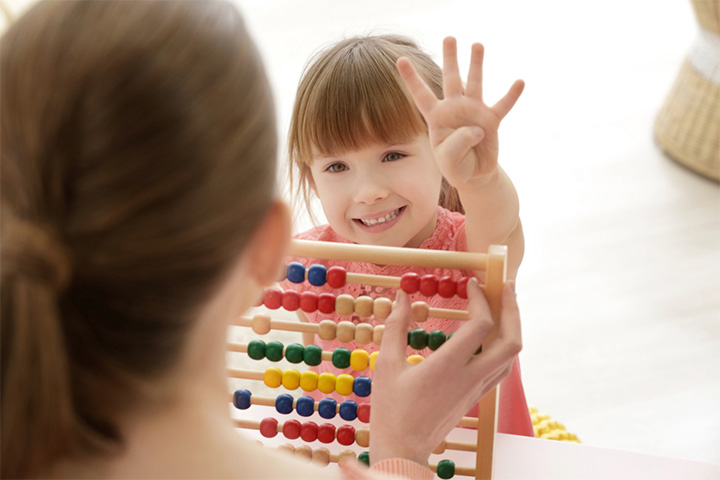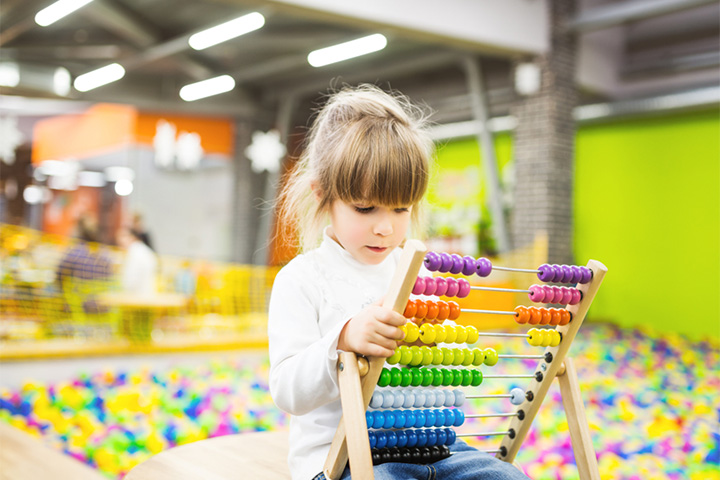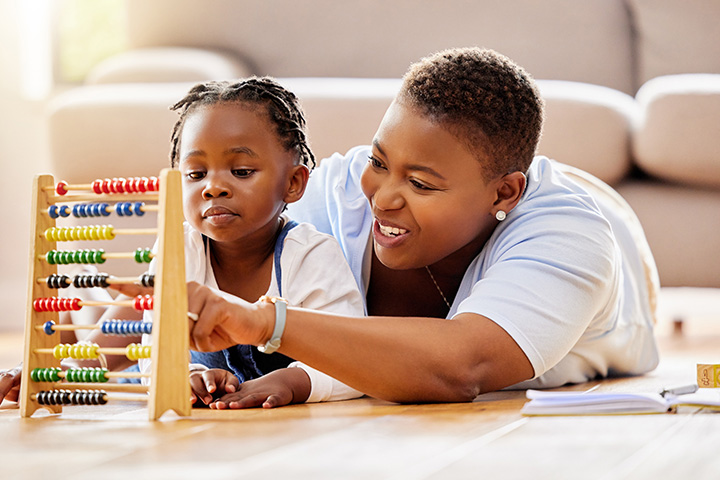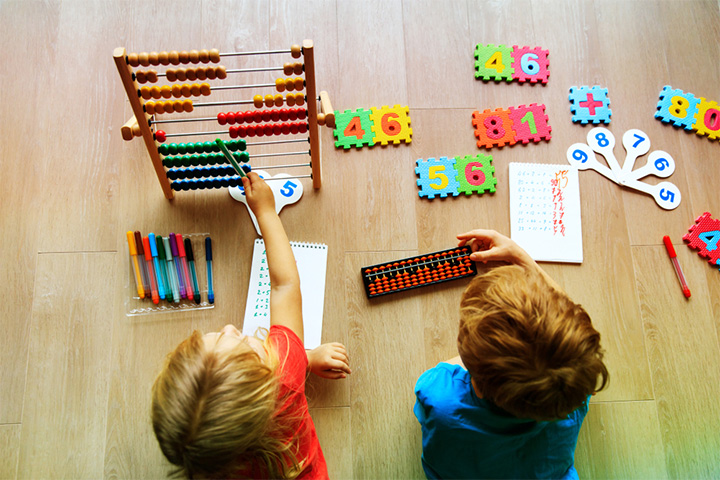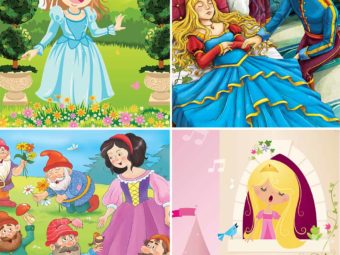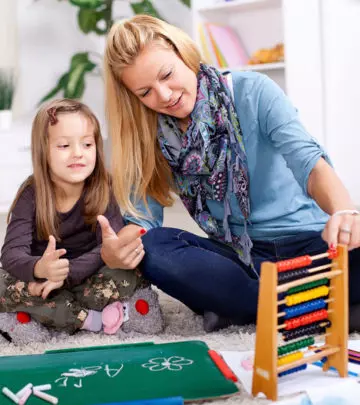
Image: ShutterStock
If you’re wondering how to use an abacus for performing mathematical calculations, you’ll be surprised at how versatile this instrument can be. Abacus came into existence before the calculator or computer came into existence. For the longest time, Eastern societies have used the abacus to calculate. An abacus is a rectangular wooden frame with horizontal bars that divide it into top and bottom sections. These have beads that allow for elaborate hexadecimal computation. Addition, subtraction, or multiplication, your kid can do it all if they know the basics of an abacus. With plenty of benefits, it would be worthy of considering introducing the abacus early on. Here we are to help you with some information on how to use it so you can use this technique to help them develop mental math skills.
What Is An Abacus?
Image: IStock
The abacus, also sometimes known as a counting frame, is a calculating tool that was predominantly used in Asia and Africa. The earlier versions were made using stones or beans that moved in grooves on sand or tablets of wood, metal, or stone. The modern abacus is mostly constructed in the form of a bamboo frame and has beads that have to be slid on wires.
What Are The Types Of Abacus?
Ideally, different countries use different types of Abacus.
- The Chinese Abacus (suanpan): It is typically 20cm tall with a wooden or metallic frame. It has more than seven rods with two beads per string in the upper portion and five beads per row in the lower section.
- The Japanese Abacus (Soroban): It consists of metal or bamboo rods with wooden beads. There is one bead per rod in the upper segment, while in the lower segment, four beads per rod are present.
- The Roman Abacus: Stones were used instead of beads on a table.
- The Russian Abacus: Horizontal positioning of the beads from right to left differentiates it from the others.
- Sumerian Abacus: It consists of a single frame with multiple columns. Beads are arranged into 60 bases.
Benefits Of Teaching The Abacus Method To Your Kid
Image: Shutterstock
Here are a few ways in which learning the abacus will help your kid:
- It boosts your kid’s development, especially between the ages of 6 and 16.
- Helps improve concentration, speed, and boosts creative abilities.
- Improves the ability to calculate mentally and enhances accuracy.
- Improves proficiency over basic mathematical concepts such as addition, subtraction, division, and multiplication.
Abacus could be a fun educational experience for your child. Ashlyn, a mother of three, shares how her daughter Emma enjoyed her Abacus class. She says, “It was just her first lesson and she somehow understood why she’s learning abacus. When we were there at trial class, Teacher Joy showed her how fast the children at Fun with Abacus could do their calculations… At her first lesson, she was given a bright yellow bag, 9-beads abacus and practice book. She was so excited about it!
“After giving an assignment to them, Teacher Koh gave Emma an introduction of abacus and went through with her the basics before getting her to do the practice. It was easy for Emma to follow because Teacher Koh was really patient and taught at Emma’s learning pace… After close to 3 months, Emma is able to do her sums (ie. x + y – z) using her abacus independently under supervision (i).”
 Did you know?
Did you know?How To Make An Abacus For Kids At Home
You Will Need:
- 10 pipe cleaners.
- Beads in 10 different colors.
- Hot glue gun
- 2 dowel rods
How To:
- Ask your kid to separate the beads as per color group.
- Lay the dowel rods in a vertical position and place the pipe cleaners on them in a horizontal position.
- Now ask your kid to twist the pipe cleaners on one end of one dowel rod and glue them in place.
- Add the beads one color group per pipe cleaner and glue the ends in place.
How To Use An Abacus For Kids: Simple Methods
All you need to teach your kid about the abacus is how to use an abacus itself. You can choose one which has two different colored beads in each row or go for a simple one in which all the beads are of the same color. Remember that before your kid learns to do more complex things on the abacus, such as addition, subtraction, multiplication or more, you will first have to teach the concept of the abacus and how to use it. Here are two simple methods with which you can help your kid to learn to use the abacus:
1. Method 1: The Match My Move Method:
Image: Shutterstock
- Make a start position on the abacus by putting all the beads on the same row. Make sure that all the beads on each row are on the same side.
- Start at the top row and move some of the beads to the other side of the abacus frame. Make sure that your kid is looking at your move as you move the beads.
- Now ask your kid to follow what you did and do the same with the beads on the row below. Your kid will have to move the exact number of beads in the direction that you moved your beads in the row above.
- Now make your move again in the next row and ask your kid to follow it carefully.
- Your kid will again have to follow your move and match it in the row below.
- To ensure that your kid does not get bored and stays on his A-game, you can change the number of beads you move at each step and also change the direction.
- Make sure that you make your moves slowly, so that your kid can follow the same.
- If your kid is quite young, you can also slowly count out the number of beads, such as one, two, three, four and so on, so that it becomes easier for your kid to follow.
- Go for different bead moving patterns such as one bead, two beads, three beads, four beads and so on with each row that you work on.
2. Method 2: The Counting Game Method:
- Start at the first row and move a certain number of beads to one side. Make sure that you do it in such a way that there is a clear partition between the two sides of the beads.
- Now ask your kid to count exactly how many beads you moved on one side and moved the same. Now ask your kid to count exactly how many beads are left behind.
- Finally, ask your kid to count both the sides of beads on the row and find out how many beads there are in all.
Both the counting game methods will help to teach your kid about basic concepts in numbers. Your kid will slowly be able to learn how to use the abacus, without getting overwhelmed with a new learning device. It will also be a great way to help your kid with arithmetic concepts.
 Fun fact
Fun factCounting And Basics With Abacus
Here are a few tips you can share with your kid about the basics of counting with an abacus:
1. Make The Placements Correct:
- Each column in the top row of an abacus will have either one or two beads and the one at the bottom will have four beads.
- When your kid begins using the abacus, make sure that all the beads in the top column are placed upwards and the ones in the column below are placed downwards.
- The beads in the top column represent the number five while each bead in the column below has a value of one.
2. Assign Place Values To Each Column:
- Each column of the beads denotes a place value.
- The column on the farthest right side is the ones place, the one next to it is the seconds place, the next third and so on.
3. Start The Counting:
Image: IStock
- To start counting, your kid will first have to push one of the beads to the upwards position.
- To represent the number one, your kid will have to push only one bead from the row below in the farthest column on the right to an up position. To represent the number two, your kid will have to do the same thing but with two beads, and so on.
4. How To Make The Beads Read Five:
- The bottom row has only four beads, so to move from the number four to five, your kid will have to make use of the bead above. Your kid will have to push one bead from the top row to a downward position and push all the four beads from the below column to a downward position as well.
- In this position, the abacus beads will read as the numeric five.
5. How To Make The Beads Read Six:
- In a similar way, to count the number six, your kid will have to push one bead from the bottom row in an upward position.
- At the same time, the bead in the top row will have to be in a downward position to represent the number five.
- Together, with one and five, it will read as the numeric six.
 Did you know?
Did you know?Addition And Subtraction With An Abacus
Image: Shutterstock
Here is how you can teach the concept of addition and subtraction to your kid with the help of an abacus:
Addition:
1. Start With The First Number:
- If your kid wants to add, for instance, 1234 and 5678, here is how you can teach the method.
- Ask your kid to push four beads in the ones place to an upwards position, three beads in the tens place to an upwards position, two beads in the hundreds place to an upwards position, one bead in the thousands place in an upward position and so on. If your kid is getting confused, refer to the place concept explained above.
2. Start Addition From The Left Side:
- The abacus uses the concept of moving from the left to the right side.
- It means that the first number that you will add will be the one and the five from the thousands place. Your kid will move a single bead from the row above in the column above to a downwards position to add the five.
- Now your kid can leave the bead at the bottom upwards to make a total of six.
- In a similar way, your kid will have to move the bead at the top in the hundreds place in a downwards position. At the same time, your kid will have to move three more beads from the bottom part in an upwards position to create an eight in the hundreds place.
Subtraction:
1. Example Of Subtracting 867 From 932:
- To begin with, help your kid enter the number 932 in the abacus.
- To get to that number, help your kid put the upper beads in an upward position. All the four lower beads in the hundreds column will also be in an upwards position.
- The three lower beads in the tens column will be in an upwards position.
- The two lower beads in the ones column will be in an upwards position.
- Once your kid gets the above bead positions correct, you can help to start the subtraction each column wise beginning from the left side.
- During the first few trials, it may seem a little hard or different for your kid to understand the basics and concepts of using the abacus. However, with a little patience and practice, your kid will soon be able to master the art of practicing numbers with the help of the same.
Moms, have your kids tried using the abacus? If yes, do share some tips to help other moms teach their kids too.
Frequently Asked Questions
1. What is the best age to start an abacus?
The ideal period to start learning the abacus is six to ten years. It is because, after six years, the child can use and move their finger muscles well (1). Also, it is the age when a child begins their schooling.
2. How long does it take to learn an abacus?
The learning time depends on the children and their grasping ability. Generally, children can complete level three of the abacus within three to four years. Level three qualification may be considered a minimum learning requirement for abacus (2)
3. Are there any mental math techniques that can be enhanced by using an abacus?
Using an abacus can enhance mental math techniques such as visualization, number sense, and calculation speed. The physical manipulation of beads on an abacus can aid in understanding place value, arithmetic operations, and mental calculations, improving overall mathematical abilities.
4. How can you improve your speed and accuracy with an abacus?
To improve speed and accuracy with an abacus, practice is key. Regularly perform calculations using the abacus, focusing on increasing your speed while maintaining accuracy. Learn and master efficient techniques for manipulating the beads. Additionally, engage in mental math exercises to enhance your overall calculation skills.
5. Does prior mathematical knowledge or aptitude affect how quickly someone can learn the abacus?
Prior mathematical knowledge or aptitude can help someone learn the abacus more quickly. Understanding basic mathematical concepts such as addition, subtraction, and place value can provide a solid foundation for using the abacus effectively. However, with proper instruction and practice, anyone can learn to use the abacus regardless of their prior mathematical knowledge.
6. How does the duration of learning the abacus differ between self-study and formal training programs?
The duration of learning the abacus can vary between self-study and formal training programs. Self-study may take longer as it relies on individual effort and pace, while formal training programs offer structured guidance and instruction, potentially leading to faster progress.
7. Can someone with dyscalculia or math-related difficulties learn the abacus, and does it take longer for them?
Individuals with dyscalculia or math difficulties can learn to use the abacus. A study revealed that a prolonged abacus course enhanced students’ arithmetic skills and short-term memory for space, outperforming those who did not take the course (3).
8. Are there any differences in the effectiveness of abacus training for children versus adults?
Abacus training proves highly effective for children aged six to ten. Commencing at a young age enables them to understand abacus principles, facilitating swift learning of addition, subtraction, multiplication, division, and mental arithmetic in just one year (1).
Abacus is a famous and well-established method of education for young learners to practice mental math and improve efficiency. It is not limited to simple addition, subtraction, division, and multiplication but also helps in effectively calculating decimal points and negative numbers. It can help prepare your child to do complicated calculations faster and score well in competitive exams. You can use a visual aid to teach your child the abacus at home or find a qualified tutor to make them an expert in calculations and increase their affinity for mathematics.
Infographic: Benefits Of Teaching The Abacus Method To Children
The Abacus method is an ancient mathematical tool that has been in use to help individuals learn and understand mathematical concepts. Today, parents are turning to the Abacus method to help their children develop strong math skills. But its benefits extend beyond academics. Explore the reasons for children to learn the skill of the abacus.

Illustration: Momjunction Design Team
Key Pointers
- A rectangular wooden frame containing beads divided into top and bottom portions by horizontal bars is called an abacus.
- Using an abacus can improve your child’s development, concentration, ability to calculate mentally, and creative ability.
- You can teach your child the concept of an abacus through methods like match by the move and the counting game.
- Ensure that all the beads in the top column are facing up, and all the beads in the bottom column are facing down.

Image: Stable Diffusion/MomJunction Design Team
Learn the basics of the abacus with this tutorial! Discover the history of the abacus, the proper technique, and how to use it. Get ready to start counting!
Personal Experience: Source
MomJunction articles include first-hand experiences to provide you with better insights through real-life narratives. Here are the sources of personal accounts referenced in this article.
i. Emma’s journey at Fun with Abacus.https://ashlynthia.blogspot.com/2019/05/mama-emma-hows-your-abacus-class-emma.html
References
- What is the best age for students to learn abacus; PAMA Global;
https://www.pamaglobal.org/post/04-what-is-the-best-age-for-students-to-learn-abacus - How long should a student learn abacus;
https://www.pamaglobal.org/post/19-how-long-should-a-student-learn-abacus - ERIC – EJ1279720 – Can Abacus Course Eradicate Developmental Dyscalculia Psychology in the Schools 2021-Feb
https://eric.ed.gov/?id=EJ1279720






